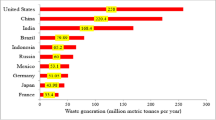Abstract
As the number of biogas plants has grown rapidly in the last decade, the amount of potentially contaminated wastes with pathogenic Clostridium spp. has increased as well. This study reports the results from examining 203 biogas plant wastes (BGWs). The following Clostridium spp. with different frequencies could be isolated via a new enrichment medium (Krüne medium) and detected by matrix-assisted laser desorption/ionization-time-of-flight mass spectrometry (MALDI-TOF MS): Clostridium perfringens (58 %) then Clostridium bifermentans (27 %), Clostridium tertium (23 %) and Clostridium butyricum (19 %), Clostridium cadaveris (15 %), Clostridium parapurificum (6 %), Clostridium glycolicum (5 %), Clostridium baratii (4 %), Clostridium sporogenes (2 %), Clostridium sordellii (1 %) and Clostridium subterminale (0.5 %). The mean most probable number (MPN) count of sulfite reducing bacteria was between 103 and 104/mL, and the higher the MPN, the more pathogenic Clostridium spp. were present. Also, real-time PCR was used to be compared with culture method for C. perfringens, C. bifermentans, C. butyricum, C. sporogenes/Clostridium botulinum and C. sordellii. Although real-time PCR was more sensitive than the culture method, both systems improve the recovery rate but in different ways and are useful to determine pathogenic clostridia in biogas plants. In conclusion, BGWs could present a biohazard risk of clostridia for humans and animals.


Similar content being viewed by others
References
Albini S, Brodard I, Jaussi A, Wollschlaeger N, Frey J, Miserez R, Abril C (2008) Real-time multiplex PCR assays for reliable detection of Clostridium perfringens toxin genes in animal isolates. Vet Microbiol 127:179–185
Bagge E, Sahlström L, Albihn A (2005) The effect of hygienic treatment on the microbial flora of biowaste at biogas plants. Water Res 39:4879–4886
Bagge E, Persson M, Johansson KE (2010) Diversity of spore-forming bacteria in cattle manure, slaughterhouse waste and samples from biogas plants. J Appl Microbiol 109:1549–1565
Baums CG, Schotte U, Amtsberg G, Goethe R (2004) Diagnostic multiplex PCR for toxin genotyping of Clostridium perfringens isolates. Vet Microbiol 100:11–16
Bhatnagar J, DeLeon-Carnes M, Kellar KL, Bandyopadhyay K, Antoniadou ZA, Shieh WJ, Paddock CD, Zaki SR (2012) Rapid, simultaneous detection of Clostridium sordellii and Clostridium perfringens in archived tissues by a novel PCR-Based microsphere assay: diagnostic implications for pregnancy-associated toxic shock syndrome cases. Infect Dis Obstet Gyn. doi:10.1155/2012/972845
Braun R, Brachtl E, Grasmug M (2003) Codigestion of proteinaceous industrial waste. Appl Biochem Biotechnol 109:139–153
Collins MD, Lawson PA, Willams A, Cordoba JJ, Fernandez-Garayzabal J, Garcia P, Cai J, Hippe I, Farrow AE (1994) The phylogeny of the genus Clostridium: proposal of five new genera and eleven new species combinations. Internat J Syst Bacteriol 44:812–826
De Medici D, Anniballi F, Wyatt GM, Lindström M, Messelhäußer U, Aldus CF, Delibato E, Korkeala H, Peck MW, Fenicia L (2009) Multiplex PCR for detection of botulinum neurotoxin-producing clostridia in clinical food and environmental samples. Appl Environ Microbiol 75:6457–6461
EC (1774/2002) Regulation (EC) No 1774/2002 of the European Parliament and of the Council of 3 October 2002 laying down health rules concerning animal by-products not intended for human consumption. Available at: <http://europa.eu/legislation_summaries/food_safety/animal_nutrition/f81001_en.ht> [accessed 28 April 2014]
Fachverband Biogas e.V. 2013. Biogas Segment Statistics (2013) Development of the number of biogas plants and the total installed electric output in megawatt [MW] (as of 11/2013). Available at: <http://www.biogas.org/edcom/webfvb.nsf/id/DE_Branchenzahlen/$file/13-11-11_Biogas%20Branchenzahlen_2013-2014.pdf> [accessed 28 April 2014]
Kikuchi E, Miyamoto Y, Narushima S, Itoh K (2002) Design of species-specific primers to identify 13 species of Clostridium harbored in human intestinal tracts. Microbiol Immunol 46:353–358
Krause L, Diaz NN, Edwards RA, Gartemann KH, Krömeke H, Neuweger H, Pühler A, Runte KJ, Schlüter A, Stoye J, Szczepanowski R, Tauch A, Goesmann A (2008) Taxonomic composition and gene content of a methane-producing microbial community isolated from a biogas reactor. J Biotechnol 136:91–101
Krüger M, Shehata AA, Schrödl W, Rodloff A (2013) Glyphosate suppresses the antagonistic effect of Enterococcus spp. on Clostridium botulinum. Anaerobe 20:74–78
Lebuhn M, Effenberger M, Garces G, Gronauer A, Wilderer PA (2005) Hygienization by anaerobic digestion: comparison between evaluation by cultivation and quantitative real-time PCR. Water Sci Technol 52:93–99
Maranon E, Castrillon L, Fernandez JJ, Fernandez Y, Pelaez AI, Sanchez J (2006) Anaerobic mesophilic treatment of cattle manure in an upflow anaerobic sludge blanket reactor with prior pasteurization. J Air Waste Manag Assoc 56:137–143
Sahlström L, Bagge E, Emmoth E, Holmqvist A, Danielsson-Tham ML, Albihn A (2008) A laboratory study of survival of selected microorganisms after heat treatment of biowaste used in biogas plants. Bioresource Tech 99:7859–7865
Shehata AA, Sultan H, Hafez MH, Krüger M (2013a) Safety efficacy of a metabolic drift live attenuated Salmonella Gallinarum vaccine against fowl typhoid. Avian Dis 57:29–35
Shehata AA, Schrödl W, Neuhaus J, Krüger M (2013b) Antagonistic effect of different bacteria on Clostridium botulinum types A, B, C, D and E in vitro. Vet Rec 12:47
Shehata AA, Schrödl W, Aldin AA, Hafez MH, Krüger M (2013c) The effect of glyphosate on potential pathogens and beneficial members of poultry microbiota in vitro. Curr Microbiol 66:350–8
Stackebrandt E, Kramer I, Swiderski J, Hippe H (1999) Phylogenetic basis for a taxonomic dissection of the genus Clostridium. FEMS Immunol Med Microbiol 24:253–258
Takeshi K, Fujinaga Y, Inoue K, Nakajima H, Oguma K, Ueno T, Sunagawa H, Ohyama T (1996) Simple method for detection of Clostridium botulinum type A to F neurotoxin genes by ploymerase chain reaction. Microbiol Immunol 40:5–11
Acknowledgments
The study was supported by the Federal Ministry of Economy and Technology of Germany, KF 2867102AJ1. Also, the authors would like to thank BioCheck GmbH (Holzhausen, Germany) for their kind help regarding the PCR.
Author information
Authors and Affiliations
Corresponding author
Rights and permissions
About this article
Cite this article
Neuhaus, J., Shehata, A.A. & Krüger, M. Detection of pathogenic clostridia in biogas plant wastes. Folia Microbiol 60, 15–19 (2015). https://doi.org/10.1007/s12223-014-0334-2
Received:
Accepted:
Published:
Issue Date:
DOI: https://doi.org/10.1007/s12223-014-0334-2




